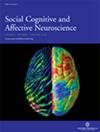Parental Emotionality is Related to Preschool Children’s Neural Responses to Emotional Faces
IF 3.1
2区 医学
Q2 NEUROSCIENCES
引用次数: 0
Abstract
The ability to accurately decode others’ facial expressions is essential for successful social interaction. Previous theories suggest that aspects of parental emotionality—the frequency, persistence, and intensity of parents’ own emotions—can influence children’s emotion perception. Through a combination of mechanisms, parental emotionality may shape how children’s brains specialize to respond to emotional expressions, but empirical data is lacking. The present study provides a direct empirical test of the relation between the intensity, persistence, and frequency of parents’ own emotions and children’s neural responses to perceiving emotional expressions. Event-related potentials (ERPs) were recorded as typically developing 3 to 5-year-old children (final Ns = 59 and 50) passively viewed faces expressing different emotional valences (happy, angry, fearful) at full and reduced intensity (100% intense expression, 40% intense expression). We examined relations between parental emotionality (as self-reported on the Nock et al., 2008 Emotion Reactivity Scale) and children’s mean amplitude ERP N170 and Nc responses. Findings demonstrate a clear relation between parental emotionality and children’s neural responses (in the N170 mean amplitude and latency) to emotional expressions and suggest that parents may influence children’s emotion-processing neural circuitry.父母的情绪与学龄前儿童对情绪面孔的神经反应有关
准确解读他人面部表情的能力对于成功的社会交往至关重要。以往的理论认为,父母情绪化的各个方面--父母自身情绪的频率、持续性和强度--会影响儿童的情绪感知。通过多种机制的结合,父母的情绪化可能会影响儿童大脑对情绪表达的反应,但目前还缺乏实证数据。本研究对父母自身情绪的强度、持续性和频率与儿童感知情绪表达的神经反应之间的关系进行了直接的实证检验。当发育正常的 3 至 5 岁儿童(最终人数分别为 59 和 50)被动地观看表达不同情绪价值(快乐、愤怒、恐惧)的脸部表情时,我们记录了事件相关电位(ERPs)的全部强度和减弱强度(100% 强烈表达、40% 强烈表达)。我们研究了父母的情绪性(根据诺克等人 2008 年的情绪反应量表自我报告)与儿童ERP N170 和 Nc 反应平均振幅之间的关系。研究结果表明,父母的情绪性与儿童对情绪表达的神经反应(N170 平均振幅和潜伏期)之间存在明显的关系,并表明父母可能会影响儿童的情绪处理神经回路。
本文章由计算机程序翻译,如有差异,请以英文原文为准。
求助全文
约1分钟内获得全文
求助全文
来源期刊
CiteScore
6.80
自引率
4.80%
发文量
62
审稿时长
4-8 weeks
期刊介绍:
SCAN will consider research that uses neuroimaging (fMRI, MRI, PET, EEG, MEG), neuropsychological patient studies, animal lesion studies, single-cell recording, pharmacological perturbation, and transcranial magnetic stimulation. SCAN will also consider submissions that examine the mediational role of neural processes in linking social phenomena to physiological, neuroendocrine, immunological, developmental, and genetic processes. Additionally, SCAN will publish papers that address issues of mental and physical health as they relate to social and affective processes (e.g., autism, anxiety disorders, depression, stress, effects of child rearing) as long as cognitive neuroscience methods are used.

 求助内容:
求助内容: 应助结果提醒方式:
应助结果提醒方式:


